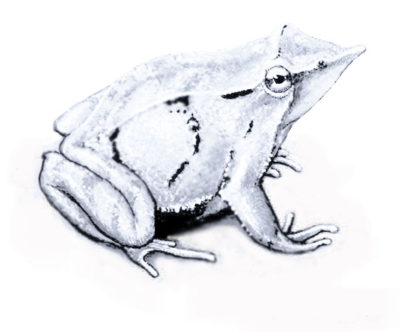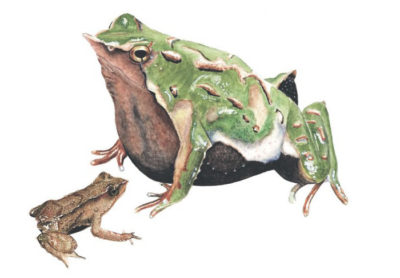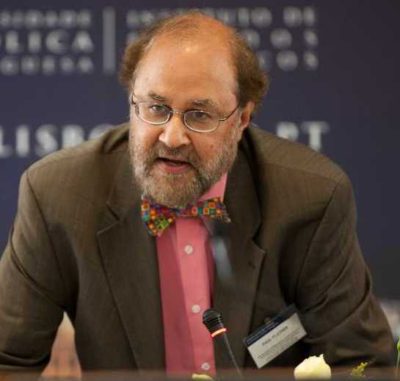 In December 1834, during the five-year voyage of the HMS Beagle, Charles Darwin described the colorings of an unusual frog on the temperate forest Island of Lemuy, Chiloe Archipelago, in his Beagle field notebook. Named in his honor, Rhinoderma darwinii, Darwin’s frog now faces extinction, not evolution.
In December 1834, during the five-year voyage of the HMS Beagle, Charles Darwin described the colorings of an unusual frog on the temperate forest Island of Lemuy, Chiloe Archipelago, in his Beagle field notebook. Named in his honor, Rhinoderma darwinii, Darwin’s frog now faces extinction, not evolution.
The only known sister Rhinoderma species, Rhinoderma rufum, was discovered by French zoologist André Marie Constant Duméril (1774 – 1860) in Argentina. In 2004, the International Union for Conservation of Nature (IUCN) listed R. rufum as “critically endangered” and R. darwinii as “vulnerable.”
Field Study
 Biologist Claudio Soto-Azat (pictured left) of the Universidad Andrés Bello, Chile, led a team of Chilean and British researchers to update the status of the two Rhinoderma species.
Biologist Claudio Soto-Azat (pictured left) of the Universidad Andrés Bello, Chile, led a team of Chilean and British researchers to update the status of the two Rhinoderma species.
The team first studied 2,244 Rhinoderma museum specimens, along with their collection locations, between 2008 and 2012. From the research, the team developed historical distribution maps for the two species.
Setting out into the 223 collection sites, the team failed to find any evidence of the existence of the R. rufum species. In the locations where R. darwinii previously lived, only 36 (16%) of the 223 sites were inhabited. (Darwin’s sketch pictured right) The average population size was just 33.2 frogs at each location. The team published the findings in the June 12 edition of the journal PLoS One.
R. rufum is virtually extinct, although not classified as an extinct species yet, even though it has not been seen since 1980. Biologists are avoiding the Romeo error (giving up on a species too early) or the Lazarus effect (bringing a species back from extinction).
Unique Species
R. darwinii (Pictured left) and R. rufum are unique species with no known transitional links. Darwin’s sketch is pictured. One of the most striking features of the Rhinoderma species is the way the tadpoles are  Raised inside the vocal sac of the male, known as mouthbrooding. Unlike most frogs, there are no free-swimming Rhinoderma tadpoles.
Raised inside the vocal sac of the male, known as mouthbrooding. Unlike most frogs, there are no free-swimming Rhinoderma tadpoles.
After the male has fertilized the eggs deposited by the female on the leaf litter, proximity is maintained. At about 20 days, when the larvae reach the wriggling stage, the male scoops the eggs up into his vocal sac.
Males are known to incubate up to as many as 19 embryos at a time. After development and metamorphosis to about half an inch, they hop out and swim away. An average-sized adult is slightly less than 1.4 inches.
Environment
The reasons for their rapid disappearance stymy Soto-Azat. It does not seem to stem from environmental changes, noting –
“Habitat loss, however, does not fully explain the enigmatic disappearances of R. rufum from its entire historical range or of the declines of R. darwinii from wild protected areas (WPAs), such as National Parks and other undisturbed ecosystems.”
Theory Issues
Why Darwin’s frogs are facing extinction is not known. Whatever the reason, why didn’t the frog evolve according to Darwin’s theory?
As is often overlooked, however, Darwin predicted that natural selection could result in either extinction or evolution. Regarding the connection between natural selection and extinction, writing in The Origin of Species, Darwin argued –
“Natural Selection almost inevitably causes much Extinction of the less improved forms of life.”
According to Darwin, then, natural selection may lead to extinction or evolution. Extinction eliminates a species, while evolution is the means resulting in speciation. Really?
Opposite outcomes, based on one proposed natural law, natural selection, justify the now widely recognized Darwin Dilemma. Evolution scientists are increasingly frustrated with Darwin’s counterintuitive theory.
Evolution Industry Angst
Angst within the evolution industry has reached a tipping point. In an interview by journalist Suzan Mazur in the book The Altenberg 16: An Expose of the Evolution Industry, cell biologist Stuart Newman of the New  York Medical College sounded the alarm –
York Medical College sounded the alarm –
“Unless the discourse around evolution is opened up to scientific perspectives beyond Darwinism, the education of generations to come is at risk of being sacrificed to the benefit of a dying theory.”
Lynn Margulis, a National Medal of Science award winner selected by President Bill Clinton, during an interview with Mazur, said –
“Neo-Darwinists are a… religious sect within the sprawling religious persuasion of Anglo-Saxon Biology.”
Darwin’s frog, facing extinction, intensifies Darwin’s dilemma.
Genesis
 Despite a flood of challenges since the publication of The Origin of Species in 1859 by Charles Darwin, and followed by more than 150 years of unprecedented efforts in the history of humankind to prove otherwise, the scientific evidence continues to be compatible with the Genesis record written by Moses.
Despite a flood of challenges since the publication of The Origin of Species in 1859 by Charles Darwin, and followed by more than 150 years of unprecedented efforts in the history of humankind to prove otherwise, the scientific evidence continues to be compatible with the Genesis record written by Moses.
Robert Boyle (1791-1867), the founder of Boyle’s Law, gives a scientist’s perspective during the Scientific Revolution –
“In the Bible, the ignorant may learn all requisite knowledge, and the most knowing may learn to discern their ignorance.”
Evidence of extinction and speciation underscores why the theory of evolution remains speculative but not scientifically valid.
Darwin’s Frog Faces Extinction is an Extinction and Speciation article.
Darwin Then and Now is an educational resource on the intersection of evolution and science, highlighting the ongoing challenges to the theory of evolution.
Move On
Explore how to understand twenty-first-century concepts of evolution further using the following links –
-
- The Understanding Evolution category showcases how varying historical study approaches to evolution have led to varying conclusions. Subcategories include –
- Studying Evolution explains how key evolution terms and concepts have changed since the 1958 publication of The Origin of Species.
- What is Science explains Charles Darwin’s approach to science and how modern science approaches can be applied for different investigative purposes.
- Evolution and Science feature study articles on how scientific evidence influences the current understanding of evolution.
- Theory and Consensus feature articles on the historical timelines of the theory and Natural Selection.
- The Biography of Charles Darwin category showcases relevant aspects of his life.
- The Glossary defines terms used in studying the theory of biological evolution.
- The Understanding Evolution category showcases how varying historical study approaches to evolution have led to varying conclusions. Subcategories include –
2020 Updates
November 2013. Environmental News Network published the following report in the article entitled “Deadly Disease Causes Extinction of Darwin’s Frog.”
“Discovered by Charles Darwin in 1834, Rhinoderma darwinii (better known as Darwin’s frogs) have been declared extinct after a killer disease is thought to have wiped out entire populations across Chile and Argentina. According to scientists from the Zoological Society of London (ZSL) and Universidad Andrés Bello (UNAB), Chile, chytridiomycosis is the main reason for this amphibian extinction.”
Chytridiomycosis is a disease of amphibians caused by a chytrid fungus (Batrachochytrium dendrobatidis) that infects the superficial layers of the epidermis, resulting in degradation of the skin, disruption of gas exchange with the environment, and eventual death due to cardiac arrest.
of gas exchange with the environment, and eventual death due to cardiac arrest.
April 2020. The International Union for Conservation of Nature lists Rhinoderma darwinii and Rhinoderma rufum on their Red List. Rhinoderma darwinii is “endangered” as of November 2017, and Rhinoderma rufum is “critically endangered” as of July 2015.
Paul Flather (pictured right), of Oxford University, Fellow of the Royal Society of Great Britain, speaking regarding the $10 million prize challenge at the Royal Society, said –
“There is, at the moment, a fierce debate about evolutionary theory. We think we are in the midst of fairly significant and radical change.”


